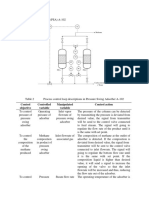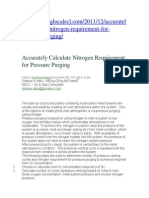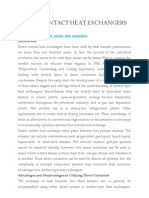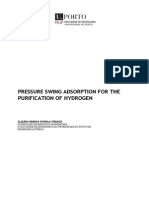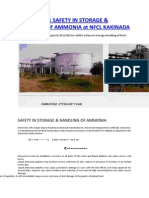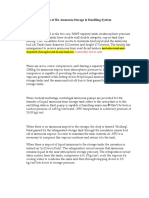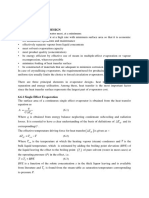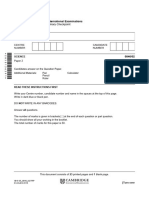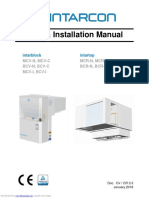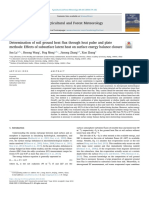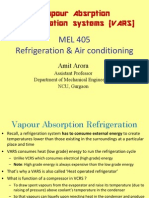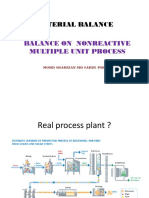Ammonia Flaring
Ammonia Flaring
Uploaded by
lagr2000Copyright:
Available Formats
Ammonia Flaring
Ammonia Flaring
Uploaded by
lagr2000Copyright
Available Formats
Share this document
Did you find this document useful?
Is this content inappropriate?
Copyright:
Available Formats
Ammonia Flaring
Ammonia Flaring
Uploaded by
lagr2000Copyright:
Available Formats
11th Stamicarbon Urea Symposium 19 22 May 2008, Noordwijk
Eleventh Stamicarbon Urea Symposium 2008
Paper 12
Zero ammonia emission, a PIC Kuwait project
Authors: Luc Dieltjens and Kees de Rijk, Stamicarbon B.V., The Netherlands Scot Smith, Zeeco Inc., USA S. Raghunathan, PIC, Kuwait
11th Stamicarbon Urea Symposium 19 22 May 2008, Noordwijk
Table of contents (Part 1)
Page
1. Introduction............................................................................................................................. 1 2. The PIC Zero Ammonia Emission Project............................................................................... 2 3. Flaring process vapors ........................................................................................................... 3 3.1 Flaring process vapors in the A-plant................................................................................ 3 3.2 Flaring process vapors in the B-plant................................................................................ 5 3.3 Purging on flare systems .................................................................................................. 5 3.4 Flaring of liquid ammonia.................................................................................................. 6 3.5 General arrangement flaring system................................................................................. 7 3.6 Design and safety aspects................................................................................................ 8 4. Absorbers on process tanks ................................................................................................... 9 4.1 Off-line urea storage tank ................................................................................................. 9 4.2 On-line urea storage tank ............................................................................................... 11 5. Conclusions.......................................................................................................................... 12
Attached hereto you find Part 2 prepared by Scot Smith, Zeeco Inc. and S. Raghunathan, PIC, Kuwait.
All technical and other information contained herein is based on general Stamicarbon/DSM experience and within this limit is accurate to the best of our knowledge. However, no liability is accepted therefore and no warranty or guarantee is to be inferred. Copyright Stamicarbon B.V.
11th Stamicarbon Urea Symposium 19 22 May 2008, Noordwijk
1. Introduction Reducing emissions from a fertilizer complex is nowadays becoming more and more important. The increasing awareness of the world community that the environment is influenced by human interference results in an increasing attention for the emissions of any kind and the drive to reduce these to a minimum. This is valid not only for West Europe but also for all other parts of the world. For urea projects we experience the requirement for offering the best available technology for emission reduction however the form may differ for the individual projects. Stamicarbon has over the years realized many different configurations designed for controlling emissions of all kinds. The final design for a specific project is however depending on the applicable local authority requirements and the philosophy of the end customer. In addition also some economic feasibility is considered in the final selection of the configuration. At this point in time we do not experience that one uniform configuration for the minimization of all emissions is developing. In this paper the design for the Petrochemical Industries Company (PIC) Kuwait, Zero Ammonia Emission Project is presented.
1.
11th Stamicarbon Urea Symposium 19 22 May 2008, Noordwijk
2. The PIC Zero Ammonia Emission Project Petrochemical Industries Company (PIC), Kuwait is currently operating two Ammonia Plants and three Urea Plants for the manufacture of liquid ammonia and Urea granules. The total capacities of Ammonia plants and Urea Plants are 1880 MTPD and 3150 MTPD respectively. Ammonia Plants are based on M/s Haldor Topsoe technology and Urea Plants are based on Stamicarbon Stripping technology. The first Ammonia/Urea plants were commissioned in the year 1966. In 1970, two more ammonia and two Urea plants were added. With the installation of another ammonia plant in the year 1984, the production capacity of PIC's Ammonia and Urea complex then became the biggest in the Middle East. PIC has always been very proactive in working with the community to meet or exceed all environmental requirements. The goal of the facility is to always be ahead of any mandatory requirements. Traditionally, the disposal of ammonia containing process gases from emergency relief systems (safety valves or rupture discs) in Urea plants has been done by discharging directly to atmosphere. This was the accepted practice for this type of facility, and continues to be the accepted practice at many locations around the world. Although direct discharge to atmosphere can be done in a safe way, it causes considerable pollution to direct plant environment. PIC as a socially responsible corporate citizen decided to eliminate ammonia pollution both inside and outside the PIC complex for such a discharge by implementing the Zero Ammonia Emission Project.
2.
11th Stamicarbon Urea Symposium 19 22 May 2008, Noordwijk
3. Flaring process vapors from safety relief devices After thoroughly analyzing the pros and cons of absorption and flare systems for the disposal of NH3-CO2-H2O mixtures discharged from emergency safety relief devices, the flaring was selected as the appropriate technology. The design included following steps: Design and implementation of a major collecting system for the ammonia sources in the facility. Replace rupture discs with safety valves. Review and analysis of the relief devices and sources in the facility to determine the impact of their relieving into a collecting system in lieu of discharge to atmosphere. Analysis of the possible relief scenarios to determine sizing of the relief system. Analysis of the collecting network for both hydraulic and mechanical considerations.
3.1 Flaring process vapors in the A-plant Figure 1:
Steam N2 Collecting header Support gas Flare Main Tip Steam N2
PSVs, rupture discs Blow-off separator
Other PSVs
Utility Flare Tip 2
Vent stack (existing) Ammonia water tank Drain tank
In case of blowing-off of a safety valve, flashing liquid or vapor enters the blow-off separator. If present, liquid will be separated from the vapor and discharged into the drain tank. The ammonia containing vapor is sent to the Flare Main Tip after mixing with support (assist) gas in order to increase its heating value allowing nearly complete destruction of ammonia by combustion.
3.
5m
Recovery
11th Stamicarbon Urea Symposium 19 22 May 2008, Noordwijk
The blow-off separator is a cyclone type with tangential liquid inlet. It is designed for the tube rupture case of the HP Stripper. The liquid from the blow-off separator is discharged to the drain tank via a 5 meter liquid seal to prevent vapor slip into the drain tank. The flare system and interconnecting piping is designed such that the maximum pressure in the blow-off separator does not exceed 0.3 barg. Because of this overpressure, the liquid from the blow-off separator will flash in the atmospheric drain tank, and the vapor will be directed to a dedicated Utility Tip 2 of flare. The pressure drop of this utility flare is such that the mechanical design pressure of the tank is not exceeded. However in order to protect the tank from possible over pressure, a manhole water seal is provided on the tank roof. The volume of the drain tank is designed to accommodate a complete synthesis drain. This might happen at tube rupture in the high pressure heat exchangers. When synthesis liquid flashes to atmospheric pressure, its temperature will drop significantly and will crystallize. To avoid blocking of the liquid outlet line from the separator to the drain tank and to maintain the exhaust systems free of solid carbamate, a continuous water circulation is maintained. It serves as dilutant for the urea/carbamate solution flowing to the tank. The initial water volume present in the drain tank is adapted to the total liquid synthesis volume. It secures that after a complete synthesis drain no carbamate crystals are present in the drain tank. In case of contamination of the tank with urea and/or carbamate, the liquid can be recovered in the process by sending it to the rectifying column. During recovery, the minimum liquid level in the drain tank should be maintained by supplying fresh steam condensate. The system configuration for the A-plant is illustrated in figure 1. The outlet of the existing vent stack is connected to the main flare header, while the synthesis safety valves are connected to the blow-off separator.
4.
11th Stamicarbon Urea Symposium 19 22 May 2008, Noordwijk
3.2 Flaring process vapors in the B-plant Figure 2:
MIN.
Flare Main Tip Support gas N2 Steam
Other PSVs
Collecting header
Synthesis PSVs
Recovery Blow-off separator Utility Flare Tip 2
Drain tank
Diluting liquid
5m
level
Circulation pump
As can be seen from figure 2, all exhaust lines from existing safety valves in this plant are now rerouted to the new collecting header. In the original design, all process safety valves (except synthesis PSVs and rupture discs) were connected to the vent stack. The bottom of this vent stack is at grade level, and as such there was no gravity overflow to the ammonia water tank as compared to the A-plant. Scenarios were possible to overfill the stack and consequently the flare with liquid in case of blowing-off of the safety valves on the carbamate pumps for an extended period of time. A detailed check also indicated that the existing vent stack will not be structurally sound in case of stack over fill. Hence it was decided to cancel the existing vent stack and reroute all the safety valves to the collecting header including the new safety valves replacing the rupture discs.
3.3 Purging on flare systems Traditionally, the safety valves of the reactor and the synthesis rupture discs are not connected to the vent stack but have a short exhaust pipe. The main reason for this design is to ensure that the safety valve outlets are not obstructed by solid carbamate as safety valves might leak. The short exhaust also allows visible inspection. In the new configuration, all safety valves are connected to the collecting header.
5.
11th Stamicarbon Urea Symposium 19 22 May 2008, Noordwijk
Figure 3:
Water flush Steam purge Safety valve
Collecting header
MIN.
To blow-off separator Water flush
To ensure that the exhaust systems are free of solid carbamate, each safety valve is provided with a purging system, see figure 3. Blow-off lines sloping upwards are purged with water, while blow-off lines sloping downwards are purged with steam. Each purge is provided with a flow meter and a high priority low flow alarm in the DCS. With a view to eliminate problems associated with PSVs passing, the flare header temperature (measured close to flare stack entry point) is maintained at 100oC with injection of auxiliary LP steam. The injection of this auxiliary steam is regulated with a temperature control loop. The flare header is also completely steam traced and insulated to minimize LP steam consumption. For safety reasons, the ingress of oxygen (air) into the flare system should be avoided. The maximum permissible O2 content in flare header is 8 vol.% to eliminate possibilities of explosive mixture formation in the flare header. This is achieved by installing purge seals in each of the three tips of the Flare. Nitrogen gas is used as purge medium. 3.4 Flaring of liquid/vapor ammonia As might be known, liquid ammonia and water have a strong affinity. A sudden release of liquid ammonia into water produces enormous pressure waves. Hence to protect the drain tank, safety valves blowing-off pure liquid/vapor ammonia are treated different as compared to process safety valves discharging NH3-CO2-H2O mixtures. The following safety valves are present at PIC: Safety valves on HP Ammonia pumps Safety valves on Ammonia refrigeration unit of Granulation plant Safety valve on HP Ammonia heater
6.
11th Stamicarbon Urea Symposium 19 22 May 2008, Noordwijk
In case of blowing-off of the above safety valves, only part of the ammonia will evaporate downstream the safety valve. The majority of the ammonia will cool down to a temperature of -33C. The time needed to evaporate all ammonia depends on insulation and the ambient temperature. Figure 4:
To safe location
NH3 refrigeration PSVs
Utility Flare Tip 1
NH3 heater PSV N2
NH3 pumps PSVs
Ammonia Knock out drum LP steam
In order to avoid carry over of liquid ammonia to Flare Utility Tip 1 and to accelerate the evaporation of liquid ammonia, the blow-off lines from the safety valves are connected to a heated ammonia knock-out drum. The volume of the drum has been optimized taking into consideration the liquid hold-up for each blowing-off case. However in order to preempt overfilling of the knock-out drum and consequently the flare header, an interlock has been incorporated to cut-off ammonia feed to Utility Tip 1 of the flare system, which does not require support gas.
3.5 General arrangement flaring system For both plants, the flares will be installed on the top of the prilling towers, which are no longer in service. The flare main tip will use natural gas as a support gas for combustion of the vent gases from the blow-off separator. There will be one utility flare tip for the vent gas from the liquid ammonia systems and one for the vent gas of the Drain tank.
7.
11th Stamicarbon Urea Symposium 19 22 May 2008, Noordwijk
Figure 5:
Pilots Utility Tip 1 Pilot Utility Tip 2
N2 NH3 Vapor from KO drum
N2 NH3 - N2 - H2O mixture from drain tank
Pilot gas
NH3 - N2 - H2O vapor from blow off separator Support gas
Flare Main Tip
3.6 Design and safety aspects Special attention has been given to several safety aspects related to the design and installation of the flare system: The design shall ensure that there will be no oxygen in the vent gases to the flares. To avoid oxygen ingress in flare tip, the system shall be kept above 100C with steam purges. The steam serves not only for inertization but also heats the system to prevent crystallization. The headers and the flare stack are steam traced and insulated. In addition nitrogen is also injected into the flare system to maintain a positive inert gas flow through the seal installed at the flare tip. Introduction of natural gas in the urea plant will require specific measures: Contamination with other media in the urea plant shall be avoided Area classification of the flare area and subsequent compliance of equipment with Ex requirements. Heat radiation levels have to be taken into account. Reliable sensors are required to detect the presence of ammonia in the main flare system. They will trigger via interlock the supply of support (assist) gas. Natural Gas Detectors shall be installed in the Main Tip flare header to monitor the presence of Natural Gas in the header. Wide range of possible compositions The vent gasses from the urea plant vary widely in ammonia concentrations and quantities. A thorough evaluation is required for the correct design of the flare. In all cases the connections to the collecting header are of the Y type in order to limit excessive forces on the piping and minimize frictional pressure drop.
8.
11th Stamicarbon Urea Symposium 19 22 May 2008, Noordwijk
4. Absorbers on process tanks At PIC, a number of atmospheric process tanks are available for intermediate storage of urea solution and ammonia water. For flexibility reasons, those tanks are connected to both plants. It is common practice that during granulator cleaning the urea production is temporarily stored in process tanks. In general, overcapacity in the granulation unit is present to recover the solution in the tank once the granulation is on-line again. While storing urea solution in process tanks, emission of ammonia is unavoidable due to the breathing of the tank (continuous rise of liquid level) and hydrolysis of urea to carbon dioxide and ammonia and the formation of biuret. The possibilities for flaring those vapors were explored but rejected for the following reasons: Some process tanks were located far away from the proposed location of the flare. This resulted in long lines which had to cross roads etc. The mechanical design pressure of a number of process tanks was limited to 150 mm H2O which was lower than the required back-pressure from the flare. Since emission of ammonia vapors from the tanks is almost always continuous due to urea solution transfer to the tanks during plant upsets and / or Granulation plant shutdown, installing a flare to destroy ammonia will not be a meaningful proposition. Hence it was decided to design low pressure drop absorbers to avoid any ammonia emission to the atmosphere.
4.1 Off-line urea storage tank As already mentioned before, ammonia emission appears due to hydrolysis and breathing when urea solution is stored during upsets in back-end section of urea plant and cleaning of the granulator. In order to make a basis of design for the absorber, a dynamic simulation was made to calculate the emission of ammonia from the tank. This is a rather complex calculation, as conditions change in time. For designing the following basis was set: Tank volume 650m3 Initial solution temperature is 100C Adiabatic conditions (no heat release from the tank)
9.
11th Stamicarbon Urea Symposium 19 22 May 2008, Noordwijk
Figure 6
Emission urea storage tank
450 400 98 350 96 300 NH3 degr. C 250 kg/h 200 150 90 100 50 0 0 10 20 30 time (hours) 40 50 60 88 94 CO2 H20 Total Temp 100
92
86
From figure 6 can be seen that the endothermic hydrolysis reaction causes a continuous drop in solution temperature lowering the reaction rate. Because of the azeotropic behavior of mixtures containing urea, water, carbon dioxide and ammonia, the emission from the tank shows a maximum as a function of time. Typically, the ammonia emission reaches its maximum after storage of about 15 hours. The design of the absorber system, see figure 7, was a challenge because of the maximum allowable pressure in the tank. The tank is foreseen with a water seal that breaks at an over pressure of 150 mm H2O. Figure 7:
Clean process condensate
Process condensate Vent absorber
LPV Purge
Urea solution
Urea solution tank
Circulation loop
10.
11th Stamicarbon Urea Symposium 19 22 May 2008, Noordwijk
By selecting low pressure drop packing and adapting the absorber design, we succeeded to achieve a maximum pressure drop of 35 mm H2O at design load in this absorber system. The expected emission of ammonia at design load is 0.0 kg/h. This absorber system will only be in operation during granulator cleaning and tank recovery.
4.2 On-line urea storage tank During process upsets, it appeared that the vacuum pressure in the flash tank could no longer be maintained resulting in emission of ammonia from the urea storage tank. Especially when the stripping efficiency drops, the ammonia vapor pressure from the flash tank off-gas becomes high, and it will be hard to condense the vapor at sub atmospheric pressure. When the liquid in the flash tank becomes above the atmospheric pressure, flashing will take place in the atmospheric storage tank resulting in ammonia emission. Figure 8:
PSV 0.5barg To main flare Condensers Desorber condensate
LPV Process condensate Flash drum Absorber LPV
Circulation loop
N.L.L.
6m
Urea Solution Tank
The basis for designing the absorber was a complete opening of the liquid level control valve (air failure to open) in the liquid outlet of the rectifying column. In this case, the tank water seal breaks which is not acceptable for the PIC case. To limit the maximum amount of vapor coming into the tank, a safety valve with a set pressure of 0.5 barg is installed on the flash tank. By providing a 6 meter liquid seal in the liquid outlet of the flash tank to the urea storage tank, direct vapor slip to the storage tank was no longer possible. The maximum vapor from the storage tank is now limited by flashing liquid from 0.5 barg to atmospheric pressure. After absorbing, the ammonia emission to the atmosphere is negligible.
11.
11th Stamicarbon Urea Symposium 19 22 May 2008, Noordwijk
5. Conclusions The PIC Zero Ammonia Emission Project is a good example how all the continuous and discontinuous ammonia emissions from the urea plant can be captured and disposed off in a controlled manner making use of either flares and/or absorbers. One should realize that the design of the different systems is a rather complicated matter as we have tried to explain in this presentation. At the start of such project the requirements of the local statutory authorities and the plant owner will have to be clearly defined. During the development of the design, regular meetings are required between the parties involved, in order to clarify what is required and to align the opinions on the different subjects that will come across in this phase. Also the required life cycle cost is an issue to be considered in these meetings. The PIC Zero Ammonia Emission Project proves that flaring is an appropriate technology for disposal or destruction of ammonia venting when plant disorder happens without disturbing the neighbours.
12.
1.
11th Stamicarbon Urea Symposium 19 22 May 2008, Noordwijk
Eleventh Stamicarbon Urea Symposium 2008
Paper 12 (Part 2)
NH3 CO2 H2O mixture flaring to reduce emissions
Authors: Scot Smith, Zeeco Inc., USA S. Raghunathan, PIC, Kuwait
11th Stamicarbon Urea Symposium 19 22 May 2008, Noordwijk
Table of contents (Part 2)
Page
1. History .................................................................................................................................... 1 2. Ammonia testing..................................................................................................................... 2 3. Assist gas injection system for main flare tip........................................................................... 5 4. Flaring equipment for PIC....................................................................................................... 6
All technical and other information contained herein is presented by their authors, at their risk and responsibility. Stamicarbon is not responsible for the contents of any presentation, the correctness thereof and no right or license as to the application thereof can be deemed to have been granted. However, no liability is accepted therefore and no warranty or guarantee is to be inferred.
11th Stamicarbon Urea Symposium 19 22 May 2008, Noordwijk
1. History Flares have been used for the disposal of ammonia vapors since the early 1970s. Many of the ammonia storage tanks that were installed in the 70s, and 80s were equipped with small flares that were designed to combust the vapors that were generated due to breathing and loading of these large storage tanks. The flares were generally small, 2 inch to 4 inch in size, and the design flow rate was also very small. During this time, there was little definitive information about the efficiency or effectiveness of using flares for the destruction of ammonia vapors. Available testing information generally indicated that 100% pure ammonia vapors could not be burned in a flare system. Engineering design guideline documents and books on the handling of ammonia vapors for refrigeration processes almost universally agreed that flaring of 100% ammonia vapors was not possible, as ignition of the ammonia could not be maintained unless it was premixed with air. Flare vendors typically approached the flaring of low btu gases, including ammonia, as follows: 1. Design the flare tip barrel diameter and exit area for the available pressure drop and resultant vapor velocity at the tip. 2. Include in the design some type of gas assist injection ring at the flare tip exit point to create a fire the ammonia vapors can pass through. This was the basic design concept for flaring of low btu and ammonia vapors for most flare vendors until the early 1980s. This is still the concept that is used by some flare vendors today. For destruction of ammonia vapors, this concept has been fully proven to be not effective. The injection of assist gas at the flare tip outlet has been shown to actually reduce the destruction efficiency of the ammonia vapors. During the mid 1980s there were multiple tests conducted in the USA by the EPA authorities on the destruction of low heating value gases in flares. These tests were performed on a large variety of gases, using CO2 and Nitrogen as the inerts. The basic conclusion was gases with lower heating values of 200 btu/scf or higher could be combusted to high efficiency in an open flame flare system.
1.
11th Stamicarbon Urea Symposium 19 22 May 2008, Noordwijk
2. Ammonia testing The first definitive testing of the combustion of ammonia vapors in a flare tip was performed in the early 1980s.The testing was performed for a major chemical company located near Houston, Texas, USA. The chemical company was expanding their facility, and needed to modify their permit for flaring to increase the total allowable emissions. The local environmental authorities would not allow the facility to increase ammonia emissions from the flare. Therefore, to expand the capacity of the facility, the company had to either install incineration equipment for the vented ammonia vapors, or prove the destruction efficiency of ammonia in the flare was actually higher than as shown in the current permit. The flare system that was installed at the facility was a standard unit with a gas assist ring to create turbulence and to create a combustion zone at the flare tip exit point. The chemical company contracted to determine the effectiveness of this flare tip arrangement versus other possible options. Testing was performed on 100% ammonia gases. The flow rate of the gas was varied to evaluate the influence of exit velocity at the flare tip discharge point on the combustion efficiency. The testing specifics are as follows: Testing was performed on a nominal 12 inch diameter utility type flare tip with a full flame retention ring. The following were options that were fitted to the tip as part of the evaluations. o Extended large diameter windshield assembly that enclosed the discharge of the flare tip and the pilots. o Gas injection assist ring at the flare tip exit point to produce turbulence and increased air inspiration into the combustion zone. o Multiple pilots (three maximum) were available to determine the impact of ignition flames on the combustion process. The testing included analysis of the performance of the flare tip assembly using various flows of ammonia, using from 1 to 3 pilots, using a gas injection ring, using the extended windshield, and using combinations of the above. The amount of ammonia present in the plume from the flare was determined using a heated probe that sampled in a position relative to the measured temperature (to ensure the probe was located in the hottest portion of the plume).
2.
11th Stamicarbon Urea Symposium 19 22 May 2008, Noordwijk
See typical ammonia test flame color in the photo below.
The conclusions from the testing were as follows: Ammonia will burn to technically complete combustion (99% or higher) if the exit velocity at the flare tip discharge point is kept very low. The acceptable velocity is a function of the nominal flare tip diameter. See attached graph for guideline exit velocities. Higher flare gas exit velocities result in the inspiration of too much ambient air into the combustion zone, which dilutes the ammonia / air mixture to below the combustible limit. Ammonia has a lower explosive / combustible limit that is 16% in air. This is in comparison to most hydrocarbons that have LEL values that are from 1 to 3%. This means the ammonia and air mixture can easily be diluted to a point where the ammonia will not burn. Ammonia needs to have a good source of ignition. This is typically provided by a very reliable pilot flame, and also a sufficient number of pilots around the perimeter of the flare tip. During the testing, if the ignition source was removed, the ammonia would not sustain a stable flame. A windshield is very useful in limiting the amount or air inspirited into the ammonia flare gas stream to facilitate ignition of the gases in an area that is protected from cross winds.
3.
11th Stamicarbon Urea Symposium 19 22 May 2008, Noordwijk
Burning of the ammonia vapor eliminates any ammonia smell. This process will also produce NOX. One mole of ammonia will produce one mole of NOX. The temperature of combustion in an ammonia flame is actually much lower than in a hydrocarbon flame. The NOX produced will typically be colorless, NO and NO2. From this testing, it was concluded that ammonia can be burned in a flare system with very high efficiency, if the flare system is designed correctly. Please note there has been other testing in the industry that has shown different results. Testing that was performed for the US EPA by EER in approximately 1986 in their flare screening facility showed that ammonia could not be ignited and would not burn. However, that test was performed on a 1/16 inch diameter orifice with the ammonia exiting the orifice at a high velocity and with no continuous pilot for ignition. Therefore, this test was not a viable reflection of the performance of an actual flare tip assembly. Testing of other mixtures of low heating value gases has confirmed a lower limit of approximately 200 btu/scf for the efficient combustion of gas mixtures. The ammonia can be mixed with inerts down to a minimum heating value of approximately 200 btu/scf. If the lower heating value is not maintained at this minimum level, assist gas must be injected / added to the flare header to ensure the lower heating value is maintained at 200 btu/scf or higher. The assist gas should be controlled to ensure this minimum lower heating value. The gas can be controlled using a ratio controller as a function of the flare gas flow rate.
4.
11th Stamicarbon Urea Symposium 19 22 May 2008, Noordwijk
3. Assist gas injection system for Flare main tip Pressure indicators, temperature indicators and ammonia analyzers are installed in the flare gas header of Main tip to sense the opening of any PSVs into the flare header. When any one of the above process sensors is activated, assist gas will be automatically injected into the flare gas header at an appropriate location to ensure thorough mixing of NH3-CO2-H2O gas mixture being relieved and assist gas for complete destruction of ammonia. On the activation of the above defined interlock, approximately 3000 Kg/hr of assist gas will be instantaneously injected into flare gas header. The maximum quantity of 3000 Kg/hr of assist gas was required for one of the PSV discharge cases whose lower heating value is lower than the threshold value of 200 btu/scf. To facilitate instantaneous injection of assist gas into Flare header on PSV blow-off, quick opening valves are installed in the assist gas line. In addition, a HCV is also provided in the line to remotely regulate the assist gas flow by the operator monitoring the color of the flame at main tip with the help of the camera provided for this purpose. Assist gas will be completely isolated once the operating staffs confirm that there is no more ammonia flow into the flare gas header. In order to avoid inadvertent closure of HCV by operating staff when quick shutoff valves remain closed, an additional interlock has been put in place. This interlock will ensure that HCV remains fully open when quick shutoff valves remain closed during normal operation by inhibiting the operation of HCV by operating staff.
5.
11th Stamicarbon Urea Symposium 19 22 May 2008, Noordwijk
4. Flaring equipment for PIC For the PIC application in Kuwait, there are two (2) separate plants, Urea Plant A and Plant B. Taking into consideration the locations of Urea Plants A & B and pressure drop constraints, it was decided that each plant would have dedicated flaring systems. Further, in each plant, there are three (3) collection systems for the ammonia vapors: NH3-CO2-H2O mixtures from PSVs, pure ammonia vapors from PSVs, and NH3-CO2-H2O mixtures from the Atmospheric Drain tank. Each flare system (Plant A and Plant B) consists of three Flare Tips, one tip dedicated for each collection system. Main flare tip for NH3-CO2-H2O mixture from PSV Vent Header Utility Flare Tip 1 for 100% ammonia from PSVs Utility Flare Tip 2 for NH3-CO2-H2O mixtures from the Atmospheric Drain Tank Vent It was a major challenge for PIC to identify a suitable location for the new Flare System in the existing Urea Plants, as there is not an obvious location with enough space either within the plant or in the adjoining areas. After analyzing the merits and demerits of the limited alternatives that were available, PIC made the decision to mount the flare systems on the top of the existing prilling towers that are located in Urea Plant A and Urea Plant B. Prilling towers were used in the process in the past to produce prills (pellets). The prilling towers are large diameter, concrete structures and are approximately 45-60 meters overall height above grade. The structures are approximately 16-21 meters in diameter, and have a flat concrete top. An engineering study was performed and it was determined the prilling towers had sufficient strength to support flare stacks. By placing the flare stacks on the top of the prilling towers, any and all possible problems due to radiation heat from the flare flames to personnel at grade was eliminated and in addition the need for an elaborate structure to install a tall self supporting structure in a grass root location was avoided. As the prilling towers are quite old, and were originally not designed to have this additional weight and wind load from flare stacks, the possible height of the flare stacks on top of the towers was limited. Based on the load stability calculations for the existing Prilling Towers inclusive of the new flare stacks, the heights of the new flare stacks were limited to 10 meters for Urea Plant A and 15 meters for Urea Plant B. At the top of the prilling tower in Urea Plant B, other process equipment, instrumentation, and electrical equipment are installed, and hence frequent plant personnel movement will be present. As the flare stack heights on the top of the prilling towers are limited due to structural constraints, the radiation levels at the top of the Prilling towers can be quite high. In addition, depending on the duration of the relief event, the associated temperatures can also be quite high. Radiation was analyzed using Zeeco proprietary software, and also using the industry available FlareSim software. Analysis was performed for several different flaring relief loads, several combination of flaring relief loads, and also for several wind speeds. For some flaring cases, the radiation levels at the base of the flare stacks on top of the prilling towers could be as high as 3,000 btu/hr-ft2.
6.
11th Stamicarbon Urea Symposium 19 22 May 2008, Noordwijk
Note the recommended limits for radiation from flare systems for personnel access and for equipment are defined in the latest edition of the API RP-521 Recommended Practice Guide for Pressure-Relieving and Depressuring Systems. The latest edition is Edition 5 from January of 2007. The recommended radiation levels for design and application of flare systems is as shown in the table below. Note the maximum allowable value for personnel actions lasting only a few seconds is 3,000 btu/hr-ft2. In reality, this predicted radiation level is extremely high, and therefore PIC determined to apply radiation shielding to all areas in the plant including the top of the prilling tower with radiation levels that could endanger personnel. In addition, additional protective measures are envisaged for the instrumentation and electrical items that could be impacted by the flare flame radiation levels or resultant temperatures.
7.
11th Stamicarbon Urea Symposium 19 22 May 2008, Noordwijk
A typical radiation graph output from the FlareSim software for one of the ammonia flaring cases with injection of assist gas at a nominal 14 meter per second wind speed is shown above. Even though ammonia has a very low heating value, and a low emissive value, the radiation levels can be very high. As noted before, the flare systems for each plant consist of three separate flare tips. The actual equipment that is being supplied for each plant consists of: Flare Tip Assemblies with Pilots and Windshields. o Nominal 78 inch diameter MAIN flare tip o Nominal 48 inch diameter UTILITY 1 flare tip o Nominal 14 inch diameter UTILITY 2 flare tip Flare support structure suitable for three (3) flare tips. Purge gas flow reduction seal devices. o Molecular type seal device for the MAIN flare tip o Velocity type seal devices for the UTILITY flare tips Utility piping and supports along the flare stack to flare stack base Retractable thermocouple assemblies from each pilot to the stack base Flare pilot ignition and status monitoring rack assembly located at grade at the base of the prilling tower. The FFG type pilot ignition system is designed to control all of the pilots on all flare tips.
8.
11th Stamicarbon Urea Symposium 19 22 May 2008, Noordwijk
The support structure was designed to support all three (3) flare tip assemblies. In addition, the site was reviewed and the wind rose information for each site was obtained to ensure the orientation of the flare tips provided the least amount of flame impingement from one flare tip to the adjacent flare tip. The three (3) flare tips are mounted on the stacks in a line, and that centerline is perpendicular to the predominant wind direction for the jobsite. See the picture below, both elevation view and top view, to understand the arrangement of the stack.
The flare stacks are equipped with ladders and platforms for access to the flare tips and pilots, aircraft warning lights and heat shields for same to warn aircraft in the area, and also with thermocouples that are retractable to the base of the stack for easy maintenance and replacement. The flare stacks including flare tips are identical in all respects except the height. As already noted, the height above the prilling tower is 10 meters for Urea Plant A and 15 meters for Urea Plant B. Purge gas flow rate reduction devices are included in each of the flare tip assemblies. The MAIN flare tip has a diffusion or molecular type purge gas seal device. The UTILITY flare tips each have a velocity type purge gas seal device. These devices are applied as a function of the operation of the flare headers, the flare gas relief frequency, the required protection level for each flare, the amount of purge gas that is required for the nominated flare tip assembly, cost of purge gas, etc.
9.
11th Stamicarbon Urea Symposium 19 22 May 2008, Noordwijk
Purge gas seal devices are described in detail in the latest edition of API RP-521 in section 4.4.3.4.2. The velocity seal devices are designed as an integral part of the individual flare tip assemblies. The diffusion seal device for the MAIN flare is designed as an integral part of the support flare stack structure. These will not be discussed in detail in this paper. The seal device types are depicted below:
The flare tip assemblies are designed with extended windshields, lifting lugs for handling, full flame retention ring for flame stability, and with multiple pilot assemblies for ignition.
10.
11th Stamicarbon Urea Symposium 19 22 May 2008, Noordwijk
See the diagram below.
The Zeeco pilot assemblies are designed to remain ignited and burning in a wind speed up to and including 67 meters per second, or in a combination of a wind speed of 50 meters per second simultaneous with a rain storm that is producing rain at the rate of 100 millimeters per hour. The Zeeco pilot assemblies are designed and fabricated from stainless steel materials and castings that are very suitable for the anticipated temperature extremes likely from a large flare system. Each pilot is monitored by a type K thermocouple in a cast thermowell.
11.
11th Stamicarbon Urea Symposium 19 22 May 2008, Noordwijk
12.
11th Stamicarbon Urea Symposium 19 22 May 2008, Noordwijk
The pilots are ignited and monitored from a pilot ignition rack assembly that is located at grade at the base of the prilling tower. The ignition rack assembly provides for the manual ignition of the pilots, and also monitors the pilot status and will automatically relight any pilot that gives indication of not burning. The ignition rack assembly includes controls for regulating the pilot fuel gas pressure. The rack assembly also includes the controls for the aircraft warning lights that are mounted on the flare stacks. The rack assembly includes a sunshield for operator protection and to keep the direct sun off the control enclosures and control components. In the event all power is lost to the FFG rack assembly, there is also a piezoelectric spark device that can be used to create a spark and generate a flame front that would travel up to the pilots to provide ignition.
13.
11th Stamicarbon Urea Symposium 19 22 May 2008, Noordwijk
Zeeco Automatic / Manual FFG pilot ignition Rack Assembly
14.
You might also like
- Pressure Swing AdsorptionDocument2 pagesPressure Swing AdsorptionaiensyafiqahNo ratings yet
- Accurately Calculate Nitrogen Requirement For Pressure PurgingDocument7 pagesAccurately Calculate Nitrogen Requirement For Pressure PurginglouayNo ratings yet
- Data Sheet For TK-5001 Cryogenic Ammonia Storage TankDocument7 pagesData Sheet For TK-5001 Cryogenic Ammonia Storage TankHamid Mansouri100% (1)
- Nitrogen BlanketingDocument21 pagesNitrogen Blanketingrvkumar61No ratings yet
- Ammonia Tech Manual 2002Document28 pagesAmmonia Tech Manual 2002Talha Bin Zubair0% (1)
- Emerson Refrigeration ManualDocument354 pagesEmerson Refrigeration Manualnewnse2008100% (1)
- Sizing Anhydrous Ammonia Storage TanksDocument12 pagesSizing Anhydrous Ammonia Storage TanksJohn NithilananthamNo ratings yet
- Minimize Evaporation Losses by Calculating Boiloff Gas in LPG Storage TanksDocument6 pagesMinimize Evaporation Losses by Calculating Boiloff Gas in LPG Storage TanksSumit KaushikNo ratings yet
- Ammonia Storage and Filling FaciltyDocument24 pagesAmmonia Storage and Filling FaciltyRavian Lhr100% (1)
- Refrigerated Ammonia Storage Tanks For Chemical Processing PlantDocument24 pagesRefrigerated Ammonia Storage Tanks For Chemical Processing Plantkresimir.mikoc9765100% (3)
- Direct Contact Heat ExchangersDocument8 pagesDirect Contact Heat ExchangersArun GuptaNo ratings yet
- Smith Industries WaterBath Indirect Heater PDFDocument29 pagesSmith Industries WaterBath Indirect Heater PDFcassindromeNo ratings yet
- Numerical Simulation of Evaporation of Volatile LiquidsDocument11 pagesNumerical Simulation of Evaporation of Volatile LiquidsVALERIA PAOLA ALARCON MU‹OZNo ratings yet
- Vacuum Drying TheoryDocument5 pagesVacuum Drying TheoryShishir Koyare100% (1)
- Boil-Off Gas CalculationsDocument14 pagesBoil-Off Gas CalculationsAlberto100% (2)
- Low Cost Reliable Sulfur RecoveryDocument11 pagesLow Cost Reliable Sulfur RecoveryiboNo ratings yet
- Ammonia StorageDocument11 pagesAmmonia StorageCristina Ion100% (1)
- P&id AmoniacoDocument2 pagesP&id AmoniacodiexboyNo ratings yet
- PSA Operation ManualDocument83 pagesPSA Operation ManualAbassyacoubouNo ratings yet
- EDO-PPP-ME-GNR-INT-XXX-013-107-108-Rev-A-AMMONIA STORAGE TANK DESIGN PDFDocument33 pagesEDO-PPP-ME-GNR-INT-XXX-013-107-108-Rev-A-AMMONIA STORAGE TANK DESIGN PDFErol DAĞ100% (1)
- Ammonium Sulfate ProductionDocument2 pagesAmmonium Sulfate Productionsinggih0% (1)
- PRG - GG - GEN - 0001 - R00 - e - Design Pressure N TempeDocument19 pagesPRG - GG - GEN - 0001 - R00 - e - Design Pressure N TempeKorcan ÜnalNo ratings yet
- Hydrogen IcsDocument16 pagesHydrogen IcsVũ PhươngNo ratings yet
- Pressure Swing Adsorption For The Purification of HydrogenDocument94 pagesPressure Swing Adsorption For The Purification of HydrogenmohsenNo ratings yet
- Ammonia Storage TankDocument13 pagesAmmonia Storage Tankjfejfe100% (3)
- Aiche-16-005 Ammonia Storage Design PracticeDocument5 pagesAiche-16-005 Ammonia Storage Design PracticeHsein WangNo ratings yet
- Commissioning of The First Ammonia-Urea Complex: A Challenging Venture For The Vietnamese EconomyDocument13 pagesCommissioning of The First Ammonia-Urea Complex: A Challenging Venture For The Vietnamese Economyvaratharajan g rNo ratings yet
- Ammonia & Ammonia Solution STORAGE AND HANDLINGDocument28 pagesAmmonia & Ammonia Solution STORAGE AND HANDLINGmah_abdelaalNo ratings yet
- Ammonia TankDocument17 pagesAmmonia TankIoana PopescuNo ratings yet
- Hot Oil System DesignDocument25 pagesHot Oil System DesignnitantharaniNo ratings yet
- Max Rhov 2 For Nozzle - Industrial ProfessionalsDocument4 pagesMax Rhov 2 For Nozzle - Industrial ProfessionalssgrsthNo ratings yet
- Glossary - Gas Encyclopedia Air Liquide - Air Liquide - InglesDocument6 pagesGlossary - Gas Encyclopedia Air Liquide - Air Liquide - Inglesvmpp222No ratings yet
- Proven Atr Technology For Modern Large Scale Methanol Plants Nitrogen Syngas Conference Feb 2014.ashx 0 PDFDocument12 pagesProven Atr Technology For Modern Large Scale Methanol Plants Nitrogen Syngas Conference Feb 2014.ashx 0 PDFAngeloNo ratings yet
- CCCCC C: C À C × C Î C C !C C!C #C $!C %&"C "C#%!Document11 pagesCCCCC C: C À C × C Î C C !C C!C #C $!C %&"C "C#%!bejoise100% (2)
- Pressure ElectrolyserDocument4 pagesPressure ElectrolyserJaviTron74No ratings yet
- Brief Description - Ammonia Storage SystemsDocument3 pagesBrief Description - Ammonia Storage SystemsVishal ThadaniNo ratings yet
- Fuel ConsumptionDocument11 pagesFuel ConsumptionMerick Diamante Jr.No ratings yet
- API Datasheet Heat ExchangerDocument4 pagesAPI Datasheet Heat ExchangerSoraya ZahraNo ratings yet
- BOG CalculationDocument2 pagesBOG CalculationAdhicahyo Prabowo100% (1)
- BORSIG Process Heat Exchanger - Synloop Waste Heat Boiler in Ammonia PlantsDocument12 pagesBORSIG Process Heat Exchanger - Synloop Waste Heat Boiler in Ammonia Plantssivsyadav100% (1)
- Ammonia Storage Tank Group No 18Document17 pagesAmmonia Storage Tank Group No 18Anonymous Xf4w0D2cNo ratings yet
- Failure of Primary Waste Heat BoilerAiche-12-008Document5 pagesFailure of Primary Waste Heat BoilerAiche-12-008Hsein Wang100% (1)
- Ammonia ManualDocument389 pagesAmmonia Manualahmed100% (3)
- Ammonia ProductionDocument28 pagesAmmonia ProductionMuhammad Ali HashmiNo ratings yet
- Haber Process For The Production of Ammonia 1Document4 pagesHaber Process For The Production of Ammonia 1Nisha SundarNo ratings yet
- Modern Ammonia Production PlantDocument58 pagesModern Ammonia Production PlantPrabal Kahar100% (2)
- Tank Venting According API 2000Document34 pagesTank Venting According API 2000Youssef Lagrini50% (2)
- 4000 MTPD Ammonia Plant PaperDocument8 pages4000 MTPD Ammonia Plant PaperJose DenizNo ratings yet
- Sulphur Magazine - Mar-Apr 2013 - Preventing Corrosion in Sulphur Storage TanksDocument6 pagesSulphur Magazine - Mar-Apr 2013 - Preventing Corrosion in Sulphur Storage TanksmarraezNo ratings yet
- Prereformer CatalystDocument20 pagesPrereformer CatalystFanni Boying100% (3)
- MDEADocument8 pagesMDEAGhifaris VashaNo ratings yet
- Electric Heaters For Safe Startup ofDocument9 pagesElectric Heaters For Safe Startup ofSteve WanNo ratings yet
- Mean Metal TempDocument1 pageMean Metal TempsankaranNo ratings yet
- 240 Nm3 Per HR - Gas Equivalent - Liquid Nitrogen ConversionDocument1 page240 Nm3 Per HR - Gas Equivalent - Liquid Nitrogen Conversionengineershoaibqazi100% (1)
- P Psa S G E P: Olybed Ystems FOR AS Xtraction and UrificationDocument2 pagesP Psa S G E P: Olybed Ystems FOR AS Xtraction and UrificationVivi OktaviantiNo ratings yet
- Ammonia Plant Cryogenic TanksDocument18 pagesAmmonia Plant Cryogenic TankslilianurNo ratings yet
- Air Separation Plant Design PDFDocument8 pagesAir Separation Plant Design PDFnagsravi100% (1)
- Urea Plant Equipments Inspection CleanDocument13 pagesUrea Plant Equipments Inspection CleanJabranYounasNo ratings yet
- articolROMAT2012rev6 ENGLDocument4 pagesarticolROMAT2012rev6 ENGLIonita TaviNo ratings yet
- Economic N2 Removal Hydrocarbon EngineeringDocument8 pagesEconomic N2 Removal Hydrocarbon EngineeringSergio JavierNo ratings yet
- "The Comparison of Stamicarbon and Saipem Urea Technology": October 2016Document11 pages"The Comparison of Stamicarbon and Saipem Urea Technology": October 2016Anonymous iuFpXLNo ratings yet
- "The Comparison of Stamicarbon and Saipem Urea Technology": October 2016Document11 pages"The Comparison of Stamicarbon and Saipem Urea Technology": October 2016Alfonso BlancoNo ratings yet
- Safe Design Against Explosions of Emission Collecting SystemsDocument6 pagesSafe Design Against Explosions of Emission Collecting SystemsdhavaleshNo ratings yet
- Celdek 5090-15 Evaporative Cooling Pad: EquipmentDocument2 pagesCeldek 5090-15 Evaporative Cooling Pad: EquipmentMurugavel VenkatNo ratings yet
- Evaporation of Sugar JuiceDocument8 pagesEvaporation of Sugar JuiceGenzo WakabayashiNo ratings yet
- Heat GameDocument41 pagesHeat Gameapi-381308026No ratings yet
- Hydrologic Processes:: Evaporation and InfiltrationDocument25 pagesHydrologic Processes:: Evaporation and InfiltrationEmmanuel LazoNo ratings yet
- Water Cycle Scavenger Hunt 1Document12 pagesWater Cycle Scavenger Hunt 1Enrique Ruiz Cano100% (1)
- Drying Technologies For Pharmaceutical ApplicationsDocument23 pagesDrying Technologies For Pharmaceutical Applicationslili&valiNo ratings yet
- Evapoprator DesignDocument17 pagesEvapoprator DesignGhost RileyNo ratings yet
- Primary Checkpoint Science Practice Paper 2Document24 pagesPrimary Checkpoint Science Practice Paper 2Jurit Malam100% (1)
- User & Installation Manual: Intarblock IntartopDocument44 pagesUser & Installation Manual: Intarblock IntartopAlex LaraNo ratings yet
- Introductory Chemistry For Today 8th Edition Seager Test Bank 1Document11 pagesIntroductory Chemistry For Today 8th Edition Seager Test Bank 1shantel100% (59)
- Articulo CientificoDocument7 pagesArticulo Cientificofariller melliraNo ratings yet
- ExperimentDocument3 pagesExperimentNitesh 19CV46No ratings yet
- Chapter SM 7: Evaporators and CondensersDocument35 pagesChapter SM 7: Evaporators and CondensersJohn Paul RodriguezNo ratings yet
- Horizon: Speed-Vap™ Iii Solvent TrapDocument2 pagesHorizon: Speed-Vap™ Iii Solvent Trap王惟申No ratings yet
- HDT 29Document18 pagesHDT 29ruben madridejosNo ratings yet
- Dr. NourDocument13 pagesDr. NourIbrahim ElgarhiNo ratings yet
- Automotive Air Conditioning Training Manual 1Document49 pagesAutomotive Air Conditioning Training Manual 1Intan Risky100% (1)
- Deep Fryingpra LakDocument10 pagesDeep Fryingpra LakLaksilu Viduraga PeirisNo ratings yet
- Methods of Separating Components of MixturesDocument27 pagesMethods of Separating Components of MixturesSrynnENo ratings yet
- Separation NotesDocument3 pagesSeparation NotesMeetaDeviNo ratings yet
- Applied Energy: SciencedirectDocument12 pagesApplied Energy: SciencedirectJaber HasanNo ratings yet
- 3.3 - Phase ChangesDocument3 pages3.3 - Phase ChangespopadoraNo ratings yet
- Marangoni Effect Coffee RingDocument5 pagesMarangoni Effect Coffee RingOjasvi MongaNo ratings yet
- Water Demand CalculationDocument4 pagesWater Demand CalculationJulius Ceasar SanorjoNo ratings yet
- 22-25 Vapour Absorption SystemDocument50 pages22-25 Vapour Absorption SystemAkshay GeraNo ratings yet
- Material BalanceDocument30 pagesMaterial BalanceJajejijojuNo ratings yet
- 2024 - Chapter 1 - Experimental ChemistryDocument21 pages2024 - Chapter 1 - Experimental Chemistrykaylamok3No ratings yet
